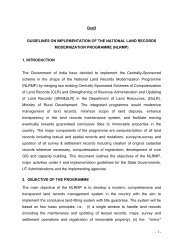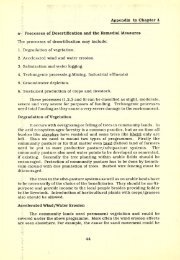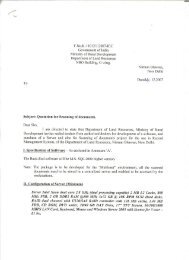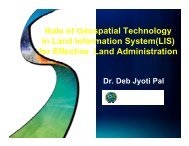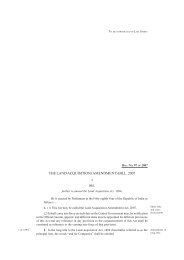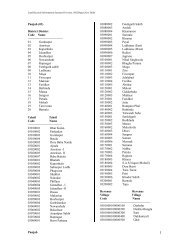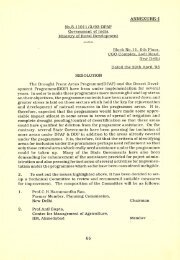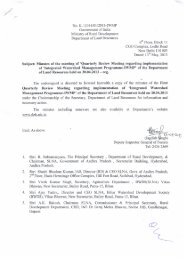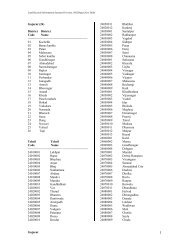Uttarakhand - Department of Land Resources
Uttarakhand - Department of Land Resources
Uttarakhand - Department of Land Resources
Create successful ePaper yourself
Turn your PDF publications into a flip-book with our unique Google optimized e-Paper software.
(Vegetables, spices<br />
and condiment)<br />
4. Terrace Repairs<br />
5. Vegetative<br />
Boundary<br />
Pressure on local forests/ vegetation for<br />
fodder for animals and packaging<br />
material.<br />
Loss <strong>of</strong> traditional / indigenous practices<br />
<strong>of</strong> crop cultivation.<br />
HYVs are labour intensive and bring more<br />
workload on women.<br />
Marginal groups (landless<br />
farmers/labourers) will less benefit, since<br />
they do not have land to bring under<br />
HYVs<br />
Due to monoculture chances <strong>of</strong> crop<br />
failure due to frost/fog, insect/pest and<br />
diseases.<br />
Discontinuation <strong>of</strong> barter system and<br />
more dependency on external resources /<br />
agents and, therefore, loss <strong>of</strong> selfdependency.<br />
Possibility <strong>of</strong> loss <strong>of</strong> local<br />
races/cultivars/gene pools/ crop varieties<br />
Conflicts among the neighbouring farmers<br />
due to the shade caste from vegetative<br />
field boundary<br />
result in lesser use <strong>of</strong> permissible<br />
chemical fertilizers and pesticides<br />
Promotion <strong>of</strong> agro-forestry will maintain<br />
biological fertility <strong>of</strong> soil.<br />
Planting <strong>of</strong> nitrogen fixing species on<br />
the crop field bunds will help maintain<br />
biological fertility <strong>of</strong> soil.<br />
Selection <strong>of</strong> low water demanding crops<br />
and rain water harvesting; storage <strong>of</strong><br />
surface water (<strong>of</strong> streams, nalla, etc.)<br />
through water storage ponds will help<br />
harvest more water for use in HYV<br />
cropping.<br />
Plantation/protection <strong>of</strong> pest controlling<br />
plants (Marigold, etc.).<br />
Levelling <strong>of</strong> crop fields and maintenance<br />
<strong>of</strong> terraces / bunds to check water run<strong>of</strong>f<br />
and soil loss<br />
Plantation <strong>of</strong> fodder species in the<br />
unculturable wastelands will supplement<br />
fodder.<br />
More participation <strong>of</strong> males in<br />
agricultural activities will reduce work<br />
load on women.<br />
Rotation <strong>of</strong> crops periodically will restore<br />
the soil fertility.<br />
Use <strong>of</strong> waste bio-products for packaging<br />
Protected cultivation (use <strong>of</strong> polyhouse,<br />
polypit, polytrench, etc.) will reduce the<br />
chances <strong>of</strong> HYV crop failure.<br />
Increase/decrease in per unit<br />
land economic benefits<br />
Changes in nature <strong>of</strong> soil<br />
(fertility, hardness, moisture,<br />
colour etc.)<br />
Quantity <strong>of</strong> seeds produced<br />
Reduction/increase <strong>of</strong> soil<br />
erosion and water run<strong>of</strong>f<br />
Increase / decrease in work<br />
load on women<br />
Number <strong>of</strong> local crop varieties<br />
grown and area under them<br />
Increase/ decrease in the use<br />
<strong>of</strong> non- chemical applications<br />
e.g.,bio-pesticides,<br />
mechanical, cultural activities<br />
140





